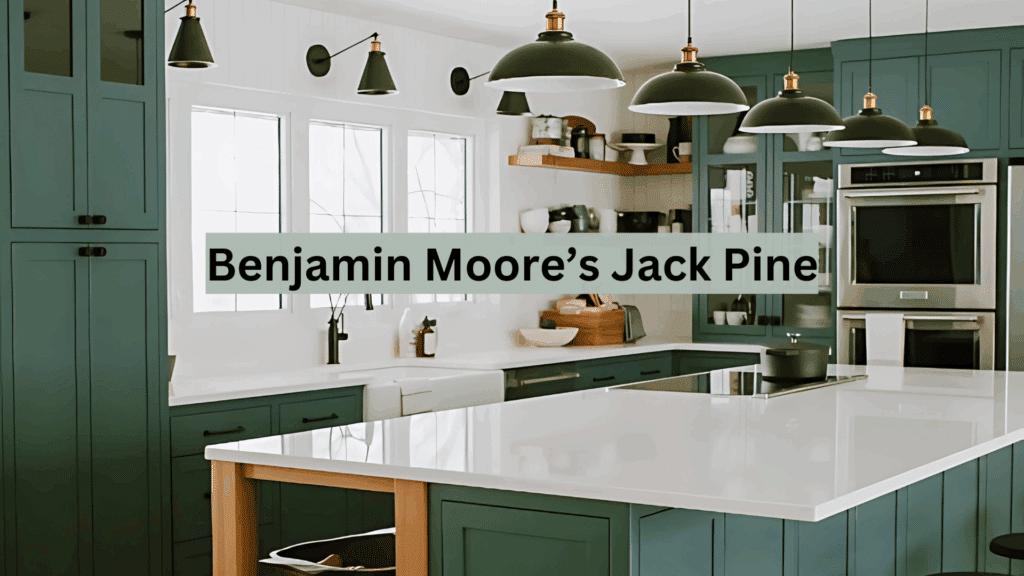Are you trying to decide if Benjamin Moore’s Jack Pine is right for your home? In this article, I’ll explain everything you need to know about this deep-green paint.
For the past 8 years, I’ve tested Jack Pine in over 20 homes. This isn’t theory—it’s real-world experience.
You’ll learn:
- What makes Jack Pine different from other greens
- Which rooms it works best in
- Perfect color pairings that enhance its beauty
- How it changes with different lighting
Finding the right green can be tricky. Too yellow, and it feels sickly; too blue, and it feels cold. Jack Pine hits that perfect balance. I’ll help you decide if it’s the right choice for your space.
The Deep Green Character of Jack Pine: What You Should Know

Jack Pine (AC-21) is a deep forest green with slight blue hints. It’s not bright or flashy; instead, it has a quiet strength that grounds a room. The color reminds me of pine trees in late afternoon shadows—it’s dark but still feels alive.
Unlike some greens that can look neon or too yellow, Jack Pine stays true to its forest roots. This paint has good coverage and usually needs just two coats. It works on both walls and furniture, giving each a rich, smooth finish.
The Mood of Jack Pine: How This Rich Hue Transforms a Space

Jack Pine creates a feeling of calm and safety. When I painted my study with this color, the room instantly felt more peaceful.
This green makes spaces feel:
- Cozy without being dark
- Natural and connected to the outdoors
- Peaceful and grounding
Large rooms with Jack Pine walls feel more intimate, while small spaces gain depth rather than feeling closed in. The color helps you slow down and breathe easier when you enter a room.
Where to Use Jack Pine in Your Home?
I’ve found Jack Pine works best in these spots:
- Kitchen cabinets: Create a rich backdrop for brass or gold hardware
- Dining rooms: Make evening meals feel extra special
- Home offices: Helps with focus and creates a den-like feel
- Living room accent walls: Draw the eye without taking over
- Powder rooms: Adds drama in a small space
This color also looks great on built-in bookshelves, where it makes book spines and objects pop. I once painted a client’s reading nook with Jack Pine, and it became everyone’s favorite spot in the house.
What Flooring Looks Best with Jack Pine Walls?
From my tests, these floors pair perfectly with Jack Pine:
- Medium-toned oak: Creates balance without contrast that’s too stark
- Walnut hardwood: Brings out the richness in both materials
- Light maple: Offers a nice contrast that brightens the space
- Terracotta tile: Adds warmth that complements the cool green
- Neutral stone: Grounds the color in nature
I avoid very dark floors with Jack Pine walls. The combo can make a room feel too heavy. Very light floors like bleached oak can work, but the contrast is strong – make sure that’s what you want.
Color Combinations that Go Well with Jack Pine
Jack Pine is a rich, deep green with subtle blue undertones, making it a versatile shade for both interior and exterior designs. This color works beautifully with several complementary palettes:
1. Swiss Coffee (OC-45)

This soft, warm white creates a classic contrast with Jack Pine. I love using it on trim, ceilings, and adjacent walls. The combination feels fresh but not stark, allowing the green to be the star without fighting against it.
2. Golden Straw (2152-50)

Gold and green are natural partners. This muted gold brings warmth to Jack Pine’s cool undertones. I’ve used this combo in dining rooms where the gold adds a subtle glow that enhances evening lighting.
3. Sienna (2092-20)

Terracotta and Jack Pine can’t be beaten for an earthy, grounded palette. The warmth of clay-inspired colors beautifully balances the forest green. This pairing works especially well in spaces with lots of plants and natural materials.
4. Hale Navy (HC-154)

Two deep colors that somehow make each other sing. I’ve used this combination in libraries and studies where the navy accents (on furniture or accessories) add depth without competing. It creates a rich, layered look.
5. Gray Owl (2137-60)

This clean, versatile gray offers breathing room next to Jack Pine. It’s less expected than white but just as effective at creating contrast. The combination feels modern and fresh while still being livable.
6. First Light (2102-70)

This unexpected pairing creates fascinating tension. The softness of the blush makes Jack Pine feel protective rather than overwhelming. I’ve used tiny touches of blush in throw pillows or artwork against Jack Pine walls with great success.
7. Kona (AF-165)

This deep, rich brown acts almost like a neutral against Jack Pine. The earthy quality of both colors creates harmony while still offering contrast. Bronze furniture or accessories look particularly striking against Jack Pine walls.
8. Marblehead Gold (HC-11)

For a bolder look, mustard adds energy and warmth. This combination feels both vintage and fresh. I use mustard sparingly – a throw, pillow, or small chair is enough to create exciting tension against the green.
9. October Mist (1495)

Creating a tonal palette with two greens adds sophistication. This lighter, softer green complements Jack Pine’s depth while adding variety. I’ve used this combo in bedrooms where the lighter sage on three walls with a Jack Pine accent wall feels both cohesive and interesting.
10. Wrought Iron (2124-10)

The depth of both colors creates dramatic intensity. This pairing works in spaces where you want a moody, enveloping feel. I often use charcoal for furniture or iron fixtures against Jack Pine walls for a rich, layered effect that still feels cohesive.
Simple Ways to Decorate with Jack Pine in Your Home
You don’t need to paint an entire room to enjoy this color. Here are some quick ways to use it:
- Paint just one wall and keep the others light
- Use it on kitchen island bases
- Paint interior doors for a touch of color
- Try it on a piece of furniture like a dresser or sideboard
- Use it in a bathroom vanity for instant character
In my own home, I painted a vintage sideboard with Jack Pine. It became a standout piece that gets lots of compliments.
Jack Pine vs. Other Deep Greens: What Sets It Apart
Jack Pine stands out in the world of deep greens through its distinctive characteristics and versatility.
| Color | Undertones | Depth | Best Uses | Room Types | What Makes It Different |
|---|---|---|---|---|---|
| Jack Pine (Benjamin Moore) | Blue-green | Very deep | Accent walls, cabinets, furniture | Libraries, dining rooms, studies | Perfect balance of depth without heaviness, stays true in various lights |
| Hunter Green (Benjamin Moore) | Yellow-green | Medium-deep | Full rooms, exteriors | Living rooms, exteriors | More traditional, can feel more country/classic than Jack Pine |
| Dark Pewter (Benjamin Moore) | Gray-green | Medium | Modern spaces, trim | Bedrooms, bathrooms | Much grayer, less rich, reads as neutral in many lights |
| Emerald Green (Sherwin Williams) | True green | Vibrant deep | Statement walls, doors | Dining rooms, powder rooms | More jewel-toned and vibrant, less subtle than Jack Pine |
| Salamander (Benjamin Moore) | Blue-black green | Very deep | Dramatic spaces | Media rooms, bars | Darker and moodier than Jack Pine, can read almost black |
What makes Jack Pine special is its depth without feeling flat or heavy. It has personality but isn’t trendy like some brighter greens. I’ve seen homes where this color has looked good for over a decade without feeling dated.
- More blue-based than Hunter Green
- Less gray than Dark Pewter
- More forest-inspired than emerald greens
- Richer than sage greens
- More natural than olive tones
What makes Jack Pine special is its depth without heaviness. It has personality but isn’t trendy. I’ve seen homes where this color has looked good for over a decade without feeling dated.
How Jack Pine Changes with Lighting?
This is where Jack Pine gets interesting. I’ve tracked how it looks in my west-facing room:
- Morning: Appears more muted, with gray undertones
- Midday: Shows its true forest green character
- Afternoon: Warms slightly as the sun gets lower
- Evening: Deepens to an almost black-green under lamps
In rooms with lots of natural light, Jack Pine stays true to color. In darker spaces, it can read as much deeper. I always test it in different parts of a room before committing.
Design Styles that Naturally Pair with Jack Pine
Not every color works with every style, but Jack Pine is pretty flexible:
- Traditional: Pairs with antiques and classic elements
- Modern farmhouse: Adds depth to white walls and natural textures
- Mid-century modern: Complements wood tones and clean lines
- Library/den style: This creates the perfect moody backdrop
- Nature-inspired: Brings the outdoors in
I wouldn’t use it in very minimalist spaces or rooms where you want a light, airy feeling, but it’s hard to beat for adding character and warmth.
Conclusion
After eight years of working with Jack Pine, I still recommend it as my top deep green. It strikes the perfect balance: bold without being overwhelming and without trying too hard.
What sets it apart is its versatility across different homes and styles. I’ve used it in modern apartments and historic homes with equal success.
The key is testing it in your space first. Buy a sample and paint a large board. Move it around your room at different times of day.
Don’t be afraid of its depth—that’s what gives it character. Pair it with light elements to create balance. With the right lighting and complementary colors, Jack Pine creates spaces that feel timeless and fresh. It’s a color investment that pays off for years.
Frequently Asked Questions
What’s the LRV of Jack Pine?
Jack Pine has an LRV of around 16.45, making it a deeply saturated color. This low LRV means it absorbs more light than it reflects, creating that rich, enveloping feeling in rooms.
How Does Jack Pine Compare to Sherwin Williams’ Forest Green?
Jack Pine is cooler and more blue-toned than Forest Green, which leans toward yellow undertones. Jack Pine feels more contemporary, while Forest Green has a more traditional, classic vibe.
Can I Use Jack Pine on My Home’s Exterior?
Yes, Jack Pine works beautifully for exterior trim, doors, and even full siding in wooded settings. I’ve seen it used on mountain cabins where it blends harmoniously with the natural surroundings.
Does Benjamin Moore Make a Lighter Version of Jack Pine?
While there’s no official “Light Jack Pine,” I often pair it with October Mist or Saybrook Sage when clients want a lighter version of the same color family that maintains similar undertones.
How Does Jack Pine Look with Brass Hardware?
The combination is stunning. Brass hardware against Jack Pine creates a rich, luxurious contrast that feels both timeless and on-trend. The warmth of brass balances the cool depths of the green.

